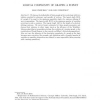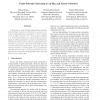77 search results - page 11 / 16 » Restricted domination parameters in graphs |
SODA
2008
ACM
13 years 11 months ago
2008
ACM
In this paper, we present two techniques to analyze greedy approximation with nonsubmodular functions restricted submodularity and shifted submodularity. As an application of the ...
COMBINATORICS
2007
13 years 9 months ago
2007
We investigate the notion of quantum chromatic number of a graph, which is the minimal number of colours necessary in a protocol in which two separated provers can convince a refe...
CORR
2010
Springer
13 years 10 months ago
2010
Springer
We discuss the definability of finite graphs in first-order logic with two relation symbols for adjacency and equality of vertices. The logical depth D(G) of a graph G is equal to ...
ICDCS
2006
IEEE
14 years 3 months ago
2006
IEEE
In this paper, we study distributed approximation algorithms for fault-tolerant clustering in wireless ad hoc and sensor networks. A k-fold dominating set of a graph G = (V, E) is...
INFOCOM
2000
IEEE
14 years 2 months ago
2000
IEEE
— An ad hoc network may be logically represented as a set of clusters. The clusterheads form a -hop dominating set. Each node is at most hops from a clusterhead. Clusterheads for...


